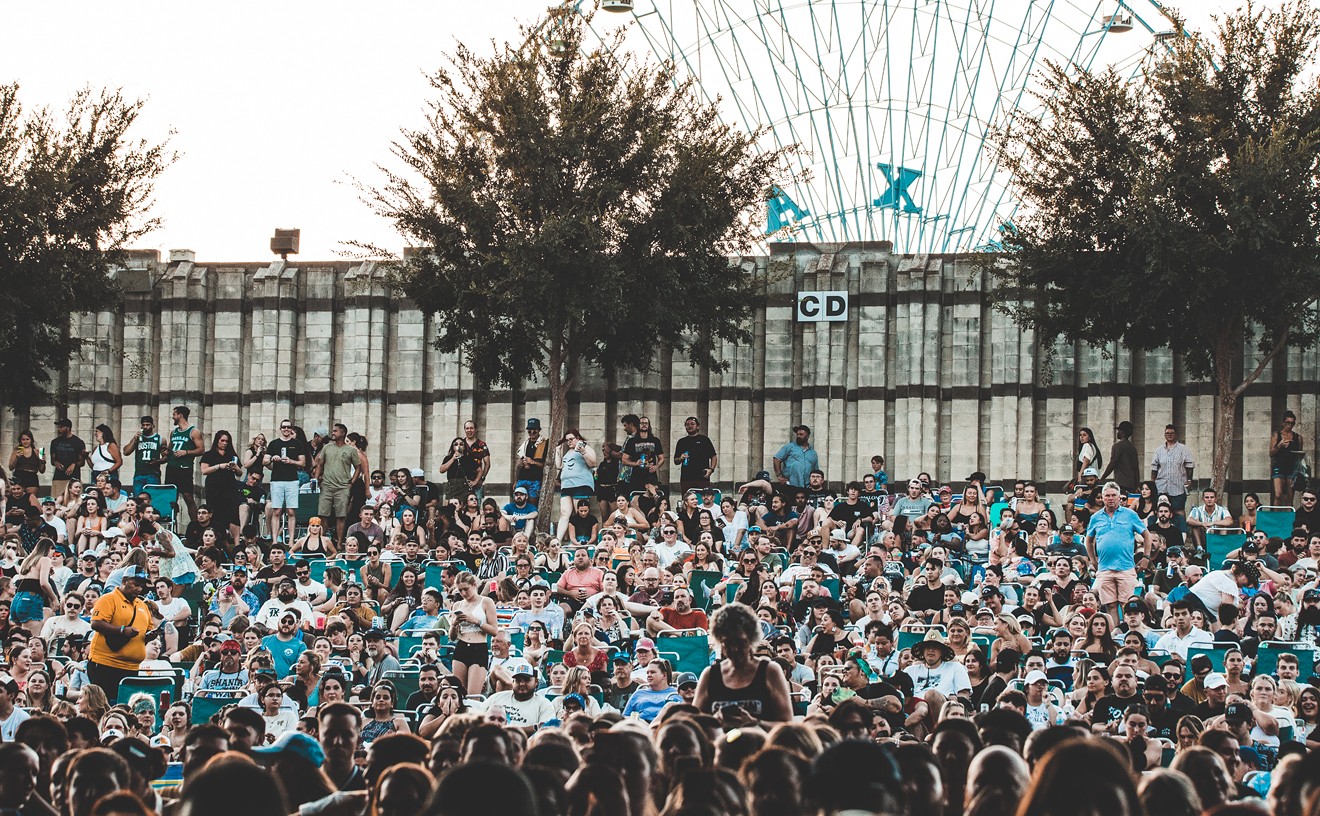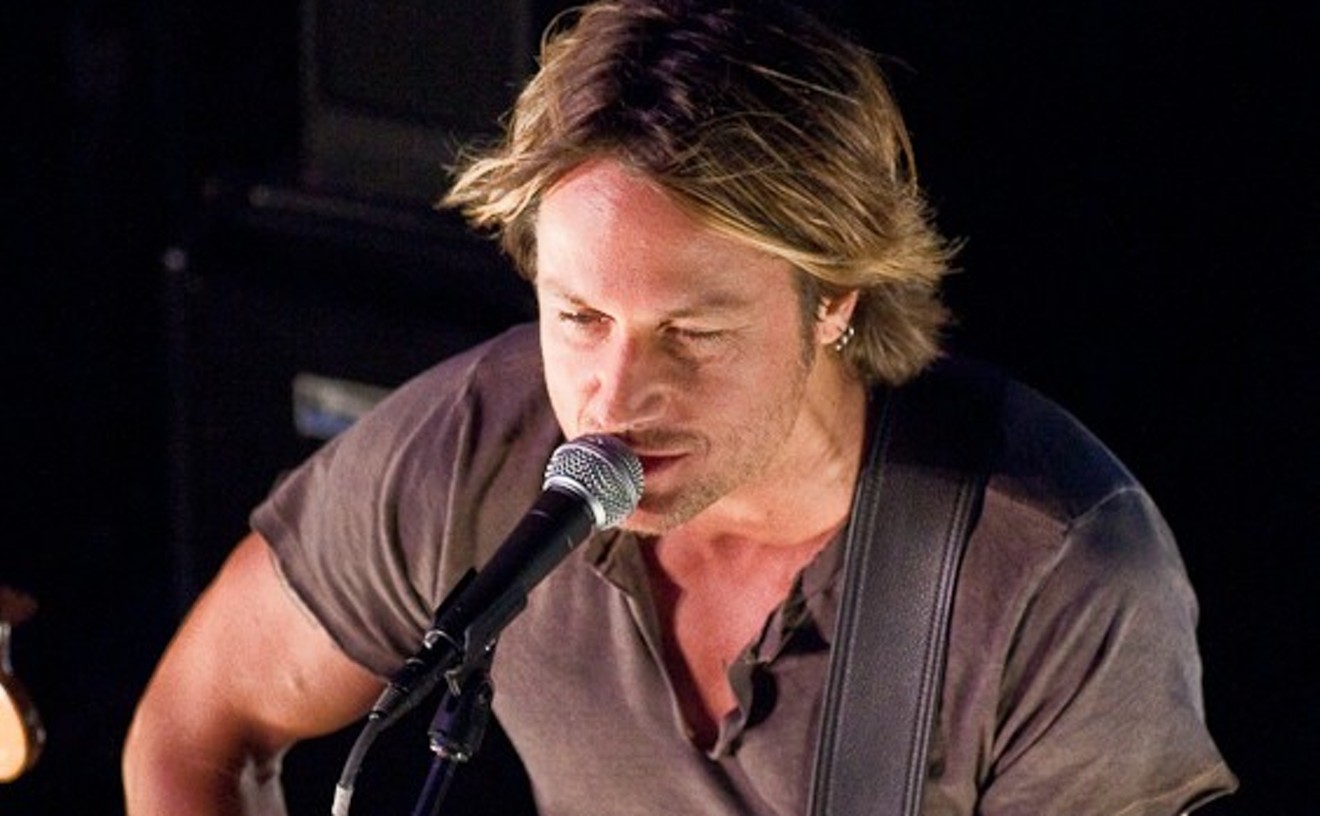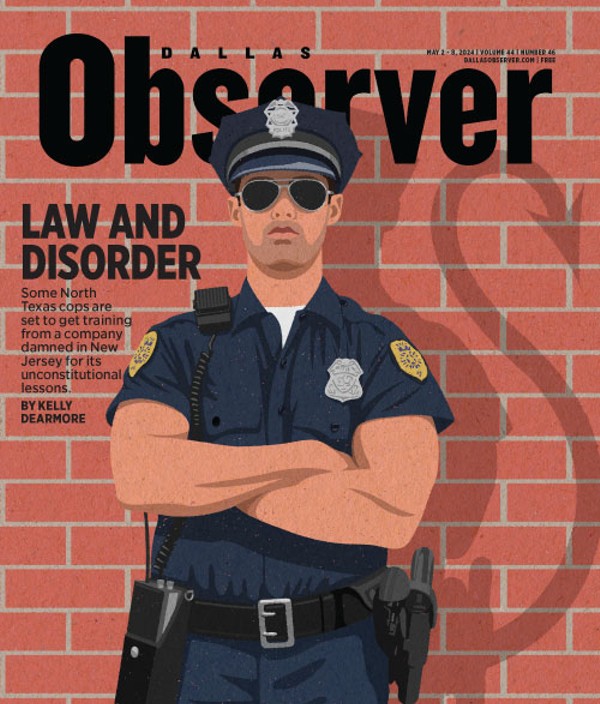And once upon a time, Dude and Juvey were real-life rock-and-rollers who drummed for one of the greatest of all the bad boys, a cat named Gene Vincent. That's right: Dude and Juvey were, at one time, members of Vincent's be-bop-a-lula Blue Caps, keeping time for one of the few musicians worthy of being called Legend.
Kahn and Gomez have been brought together this late March evening by David Dennard, the man responsible for releasing the first albums by Tripping Daisy and Hagfish on his Dragon Street Records label earlier this decade. But Dennard isn't so interested in finding the hottest, newest thing anymore. Indeed, he has spent the past few years digging up music long since buried and long thought forgotten--music recorded by Vincent right here in Dallas during the late 1950s, when the rockabilly idol briefly lived here to be near his manager, Ed McLemore.
It was a quest that began in a North Dallas closet and ended in a Washington, D.C., basement. For a music fanatic like Dennard, just to be around men such as Gomez and Kahn is a thrill, like touching the hem of history.
On April 7, Dennard will release the fruits of his labor: a 19-song collection titled The Lost Dallas Sessions, 1957-'58, featuring tracks Vincent recorded at Sellars Studios, the Big "D" Jamboree at the Sportatorium, and, believe it, a North Dallas home. It's a remarkable record, not just odds and sods and other scraps swept from the studio floor and packaged for profit on disc, but a bona fide treasure--the sort of record that fetishists crave and even the casual fan can understand and appreciate.
The disc contains classic rockabilly and then some, offering proof that Vincent--who was, in truth, really a one-hit wonder whose time came and went quick enough for him to become immortal rather than insignificant--wasn't just a myth but a wonderful musician with a gut-shot voice and a bluesman's fingers. The opening track alone proves worth the 40-year wait: Titled "My Love," it features Vincent all by his lonesome, strumming and moaning like a back-porch preacher. It's a thousand miles away from the hopped-up rock and roll that made him a sensation in 1956, and proof that even now, decades-old music can still offer a revelation or two beneath all that dust.
"Gene was the original punk-rocker," Dude says now. "He was really talented and had a super ear. He had more black blood in him than any other white guy around, even more than Presley. Gene was a soulful cat. He was in-your-face and real skinny and had that messed-up leg [from a childhood car accident] and drank, but he had soul."
David Dennard's discovery of these lost Vincent tracks began by accident: During the course of assembling the 1996 two-disc Ronnie Dawson anthology for Crystal Clear Sound, where Dennard worked till a few months ago, he had reason to call a woman named Jeanne Bullington, the daughter of Ed McLemore. McLemore had become famous around town for booking wrestling into the Sportatorium, and he also ran the Big "D" Jamboree there, bringing in country and rock acts and broadcasting them nationally over the CBS radio network. McLemore also managed, for a brief time, Gene Vincent.
Dennard was looking for photos of the young Dawson performing on the Sportatorium stage, and Bullington told him that she did indeed have some old pictures of the teenage Ronnie Dee. Moreover, Bullington said, she also owned some old tapes featuring Dawson and other musicians who used to work with her father and his Big D Music publishing company. She asked Dennard if he'd like to see and maybe hear the tapes. He answered with a breathless yes.
When Dennard arrived at Bullington's Northwest Highway apartment, she presented him with a box of master tapes featuring a handful of unreleased Dawson tracks. Then, Dennard says, "at the bottom of the tape was written 'G. Vincent,' and I went, 'Oh, my God, this is Gene Vincent.'"
It turned out Bullington was sitting on the mother lode, storing in her closet dozens of tapes featuring artists who worked with Ed McLemore, including Johnny Carroll and myriad country artists who played the Jamboree. Over time, Dennard worked out a deal to license the material from Bullington. When she died last summer of cancer, her son Michael took over.
The tracks Bullington possessed were recorded in 1958 at Sellars Studio near downtown, which hasn't existed in decades. They feature mostly second-generation Blue Caps or none at all. Most original members, including guitarists Cliff Gallup and Willie Williams and bassist Jack Neal, had long grown tired of touring and had become frustrated with the lack of chart success following "Be Bop A Lula," which had been released in 1956. They quit, taking session work or leaving the business for good.
Vincent had been left without a band and, shortly afterward, without a manager. Capitol Records producer Ken Nelson, the man who recorded all of Vincent's tracks for the label, suggested he contact McLemore in Dallas. McLemore ended up not only bringing Vincent to town in 1957, but he also provided the band with new uniforms and a place to live--a ranch-style home on Dyke's Way near Forest and Hillcrest, where Gene, his girlfriend, and the Blue Caps lived for a few months.
For the Sellars sessions and his road band, Vincent and McLemore hired such players as bassist Ken Cobb, pianist Cliff Simmons, drummer Clyde Pennington, and guitarist Johnny Meeks. They demo-ed such tracks as "Hey Mama" (which later became "Say Mama"), "The Night is So Lonely," "Lonesome Boy," and "Lady Bug," which appear on The Lost Dallas Sessions and were later recorded again in Capitol's Hollywood studios. "Hey Mama" also features Ronnie Dawson on guitar.
Dude Kahn doesn't appear on any of the recorded demos; indeed, he only played with Vincent for about three months in mid-1957. Kahn had been Sonny Curtis' drummer--Curtis was a Capitol labelmate of Vincent's and was also managed by McLemore--and filled in only after original Blue Cap Dickie Harrell quit the band because of the rigors of touring. Kahn, who joined the Blue Caps when he was just 16, gave the same reason for his departure.
"Sonny let me go after two years, because I was getting as much attention as he was," says Kahn, who was indeed quite the teddy boy back in his day. "That's the truth. He said, 'Go get your own show. You're gettin' all the chicks.' He didn't need me. So then I went on the road with Gene and the Blue Caps. I always liked the band, because it was a funky band. All the other bands were just rockabilly bands, but Gene's band was like a blues band, an R&B band, with the bass player playing a four-beat instead of a two-beat.
"It was a funky band, but on the other side of the coin, it was a funky band. Whoo. I mean, they toured in a 1957 Ford wagon and threw all the trash on the floor, and they trashed motel rooms. At the end of my third month with them, I had had enough."
Kahn quit and then rejoined the Blue Caps for a short time, until he was replaced in the fall of 1957 by D.J. Fontana--better known as Elvis' drummer. Dickie Harrell was convinced to return to the band in December 1957, and he stuck it out till March 1958, when he quit for good--right before the band was scheduled to appear in the rock and roll B-picture Hot Rod Gang. Vincent needed a drummer and quick; he had been impressed by a 15-year-old kid named Juvey Gomez, who was playing with Johnny Carroll.
"Gene said he was looking for a drummer and approached me, and then I went to ask Johnny Carroll if it was OK, since we had been working together six or nine months," Gomez recalls. "The whole group sounded great, and Johnny said, 'I hate to lose you, but I'll tell Gene [you're joining]."'
Juvey, with his mother's blessing and his teachers' permission, was snatched right out of his classes at Spence Middle School in East Dallas and plunked down behind the drum kits in Gene Vincent's Blue Caps. He played with Vincent for only a few weeks--but long enough to appear in Hot Rod Gang (the cover photo for The Lost Dallas Sessions was taken from the movie), then record with Vincent in Los Angeles (he plays on, among other tracks, the astonishing "Git It"), and perform a few West Coast dates with a few R&B musicians as Vincent experimented with playing in front of black audiences.
"I was hardly in the movie because of child-labor laws," Gomez recalls. "I enjoyed it all, recording in Frank Sinatra's studio, Studio B at Capitol Records. But the biggest thrill was right next door: [jazz pianist] George Shearing was recording, and by then I was already into jazz. One night, as I walked out, I heard this beautiful piano and guitar, and I looked up, and there was George Shearing. That was cooler than playing with Gene Vincent. Without a doubt. And Gene knew it."
Juvey lived a teenager's fantasy: He played with Gene Vincent and became friends with Ricky Nelson and Eddie Cochran. He played in front of packed houses and met his jazz idols. He recorded in the house Sinatra built and branded his name in the history books by laying down the drum tracks on some of Vincent's finest, most underappreciated material.
But by April 1958, Gomez quit the band and returned to school. Like all of the Blue Caps before him, he had burned out.
In May 1957, before Vincent moved to Dallas, the Blue Caps were touring through town and ended up at the North Dallas home of the mother of former oilman Tom Fleeger, who had gotten himself involved in the music business. Fleeger was representing a Dallas songwriter named Bernice Bidwell, who had written a song called "Lotta Lovin'," and he somehow convinced Vincent to stop over at his mother's house on Sherry Lane and demo the song. He also got Vincent to try out another song Bidwell had written, "In My Dreams," plus Mary Tarver's "Nervous," which later became a hit for Gene Summers.
During the course of tracking down Vincent information, Dennard stumbled across Fleeger's tapes and got his permission to put them on an album with the Sellars demos. That gave Dennard material for 11 tracks, but not enough for a full-length disc. Only after many more months of detective work would Dennard discover that the Country Music Hall of Fame in Nashville was sitting on acetate transcriptions of old Big "D" Jamboree broadcasts--featuring, among others, Carl Perkins, Ronnie Dawson, and Gene Vincent--which had been recorded by the Army and sent to troops overseas. (The Army also recorded the Old Dominion Barn Dance, the Louisiana Hayride, and other regional country and rockabilly shows from the 1950s.)
Yet Dennard could never negotiate a deal with the Hall of Fame to license and release the tapes, and he left Nashville frustrated. "I got really fed up with them," Dennard says. "So I finally said, I'm going to go to Washington, D.C., because I heard in talking to the Library of Congress that they had an entire set, and all you have to do is book some time and go in, and they'd play them for you."
In the Library's basement, Dennard discovered just what he was looking for: at least 15 minutes of Vincent and the Blue Caps live at the Sportatorium, performing "Whole Lotta Shakin' Goin' On,'" "Dance to the Bop," "Lotta Lovin'," and the immortal "Blue Jean Bop." After hours of listening to each disc and unearthing the tracks, Dennard finally had enough to put on his Vincent CD--all he had to do was convince Michael Bullington to let him release the music. It was a done deal, and within weeks, Dennard received from the Library of Congress a Federal Express package with digital audiotapes featuring the Vincent performances. All it cost him was $600.
Interestingly, the date of the Big "D" Jamboree performance, according to the information Dennard has, was October 24, 1958--the same time Vincent biographers have him in Hollywood cutting his final Capitol sessions. Indeed, there are still questions about who's playing on some of the tracks. But Dennard's lucky enough to have the music, much less the names of the musicians who play on the long-lost tracks. Vincent, of course, isn't around to confirm the information: He died of ulcer trouble in L.A. on October 12, 1971.
Dennard hopes at some point to release an entire set of discs featuring all the Big "D" Jamboree material, including many of the artists, famous and obscure, who graced the Sportatorium stage. But for now, he's content to present one final piece of the puzzle that was Gene Vincent's life and music, releasing the disc in the States on Dragon Street and abroad on Roller Coaster. "I should do a book, I've got so much stuff on the Big 'D' Jamboree," he says. "I've got movies, I've got pictures, I've got shows. It's wild. It'll blow your mind. All of this has been a labor of love, maybe one of the greatest things I've ever done in my life."
Scene, heard
Speaking of rockabilly legends, Ronnie Dawson's new record, a live album cut in January at the Continental Club in Austin, will be released early in April. Featuring all the should-be hits and then some, the disc will be released by the Austin-based Continental Records, home to 8 1/2 Souvenirs, and there will be limited distribution. Also, Dawson's "Yum Yum Yum" is featured in Primary Colors, during a backyard barbecue scene...
Caulk will celebrate the release of its third album, Imaginary Enemy, with a handful of upcoming shows, beginning with a gig on March 27 at the Curtain Club with Baboon and Fixture. On April 3, they'll play Rick's Place with One Ton labelmate Slow Roosevelt and Fixture, who will share the bill with Caulk the following night at the Aardvark. We like the record just fine--it, oh, rocks--but we're even more fond of the publicity photo that refers to Caulk frontman and One Ton Records boss Aden Holt as Dean Brodie...
Hard to believe, but the Vas Deferens Organization will play publicly for the first time ever--well, aside from a little "fucking around" several years ago, says VDO co-frontman Matt Castille--March 27 at the Orbit Room. The band will open for Chrome, the band fronted by prog guru Helios Creed. Denton's Light Bright Highway will also share the bill.
Send Street Beat tips, gripes, and pipe bombs to [email protected].










